



View navigation
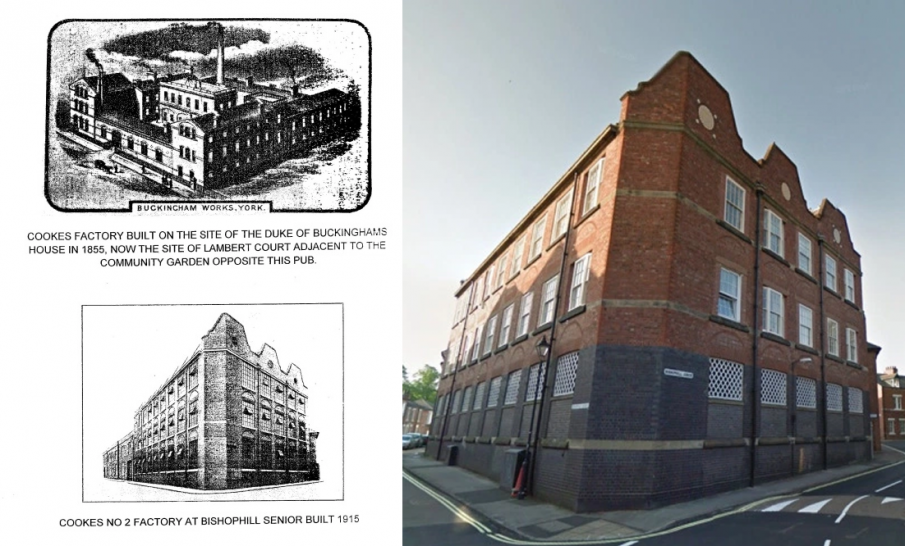
Before World War One, the world famous York firm, T E Cooke, had been making scientific instruments and equipment for the military, including rangefinders and surveying equipment. They opened a new factory in Bishophill in York in 1915 and took on women to help with production. The new factory was built close to the old one, but only part of the factories remain now.
 Ella Dunnington Jefferson came from a wealthy background. The family had lived at Middlethorpe Hall until 1911, when they moved to Thicket Priory, near Thorganby, which they owned. Their home had originally been a priory but the Dunnington Jefferson family demolished this in the 1840’s and built a brand new country house. Curiously, the family sold Thicket Priory in 1955 to the Carmelite sisters of Exmouth and it became a religious house once more.
Ella Dunnington Jefferson came from a wealthy background. The family had lived at Middlethorpe Hall until 1911, when they moved to Thicket Priory, near Thorganby, which they owned. Their home had originally been a priory but the Dunnington Jefferson family demolished this in the 1840’s and built a brand new country house. Curiously, the family sold Thicket Priory in 1955 to the Carmelite sisters of Exmouth and it became a religious house once more.
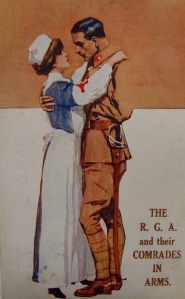 Ella was 26 years old when she started at Cooke’s. She had already been working as a nurse and orderly at Clifford St and Nunthorpe Hall Auxiliary Hospitals. These VAD hospitals tended to look after convalescing military personnel, rather than acute cases, but Ella would have had a pretty realistic impression of what the war was doing to servicemen by the time she started at Cooke’s. She would probably have looked somewhat askance at the postcard images of what women nurses were supposed to have been doing at the time.
Ella was 26 years old when she started at Cooke’s. She had already been working as a nurse and orderly at Clifford St and Nunthorpe Hall Auxiliary Hospitals. These VAD hospitals tended to look after convalescing military personnel, rather than acute cases, but Ella would have had a pretty realistic impression of what the war was doing to servicemen by the time she started at Cooke’s. She would probably have looked somewhat askance at the postcard images of what women nurses were supposed to have been doing at the time.
Records for T E Cooke, held at the Borthwick Institute, include the humorous A Munition Dirge that Ella wrote about her experiences at Cooke’s. It paints a picture of an assortment of displaced ‘ladies’ who are only working at the firm ‘on suffrance’. Their foreman, Harrison who terrifies them, holds them in check. There are hard workers such as Miss Blaylock and her sister, and the not-so-hard workers, like Ella herself and Miss Radcliffe, who seems to spend most of her time day dreaming. The dirge ends on a patriotic note, however and Ella seems proud to be doing her bit towards World War One.
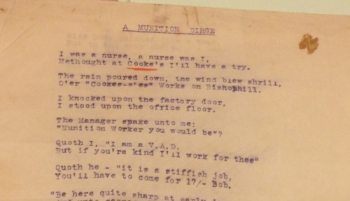
Ella mentions two sisters in her Dirge. We believe they are Evie and Dorothy Dodsworth, who lived at ‘Redholme’, St Peter’s Grove York in 1911 – their father Ernest Ralph Dodsworth was a solicitor. They had worked as nurses at no 12 General Hospital in Rouen in 1915, before they joined Cooke’s. Number 12 General Hospital was a functional hospital with an operating theatre and X Ray facilities but it was muddy, and patients were accommodated under tents. Life at Cooke’s must have been quite a different experience from life in Rouen, and certainly a lot cleaner.
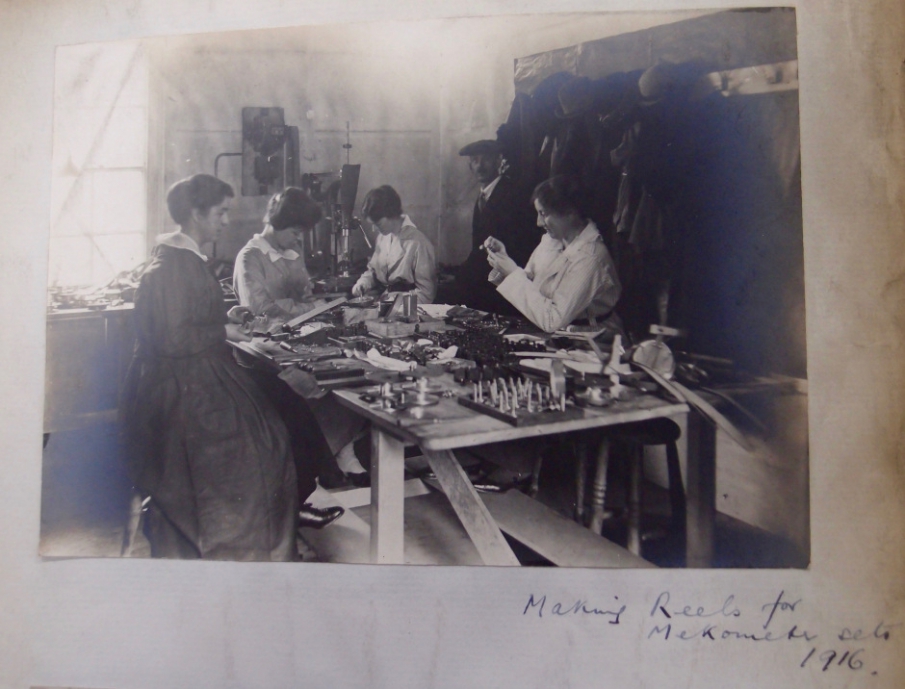
Photographs of the women at work at Cooke’s in 1916 show that the work was clean enough not to require overalls – it looks as though most of the girls are wearing their own clothes with some, but not all of them wearing aprons. It is highly likely that some of the girls on the photograph are the ones mentioned in Ella’s Munition Dirge, as Ella specifically mentions painting ‘reel’. Mekometers were a type of rangefinder that comprised two lightweight sextants connected by al long cord wound round a reel. (They were an instrument for the accurate measurement of distances by means of reflected polarized light).
The Dirge includes the following line “There was Harrison our Overseer, Who caused us all to quake with fear.” Cooke’s records show that there were three people called ‘Harrison’ who could have been Ella’s foreman and we would like your help to trace the ‘real’ Harrison. Two ‘Harrisons’ appear on a staff photograph taken in 1912.
Our best contender is one William Charles Harrison, who did at least 25 years service at Cooke’s and was working there in 1922. W C Harrison lived in our area at 2 Thorpe Street until 1944. He would have been 59 years old in 1915. He is identified on staff photographs as W Harrison – I can’t help but think he must have dropped the ‘C’ in his name for fear of ridicule and comparison with ‘water closets’.
There was also one Arthur Acklam Harrison who lived again locally at 38 Nunthorpe Road who would have been 48 in 1915. A rather enigmatic note on staff photos records that A A Harrison always declined to have his photograph taken, so we have no visual record of him.
The other Harrison who might have been Ella’s foreman was one A Harrison but I cannot find a record of him at all – and would appreciate any help in finding him or identifying any of the employees on this photograph.
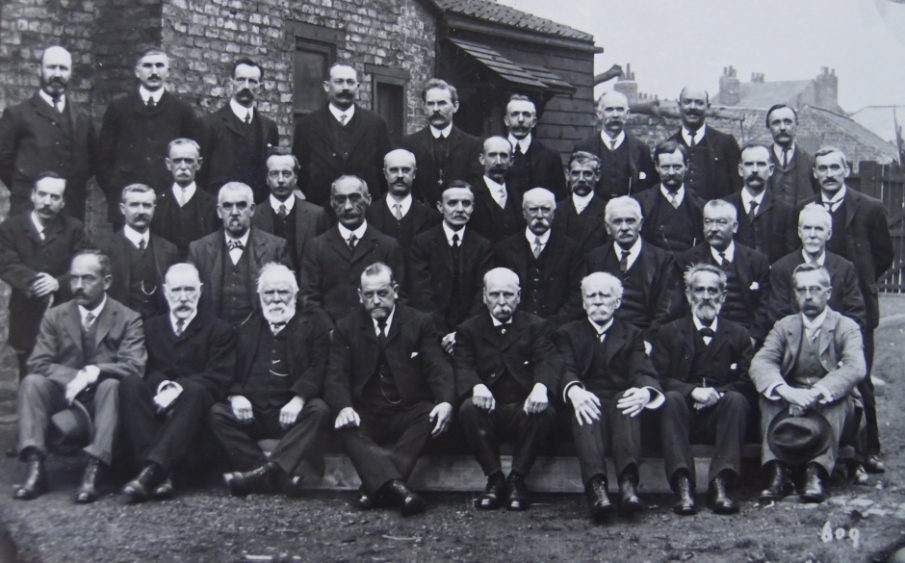
Back row, left to right J Ellingworth; A Sutherland; E Ridsdill; A Pashley; W H Jones; T Dwyer; H Shepherd; J Jackson; A Waddington
Second from back row, left to right W Eyeington; A Harrison; W Smallwood; J Colley; J Metcalfe; G Milner; T Jefferson; G Dindsdale
Third from Back row, left to right B Smithson, T Ashworth; W Gill; W Johnson; W Harrison; J Graham; T Pashley; H Pears; T Nelson
Front row, left to right A Taylor; C Rotherham; S Yardley; J Douglas; G Wilson; T Patterson; H Muller; H D Taylor
If you want to learn more about Ella, Evie, Kit and Harrison do come to our performance of this song and exhibition at York Explore at 1.30 on Saturday 26 November, where there will be lots of fascinating information from us and other local history groups.
With grateful acknowledgements to Sue Raines for alerting us to this wonderful document, Bishophill Local History Group, and the Borthwick Institute for Archives.
Ancestry.co. uk
Borthwick Institute, University of York T E Cooke archive
British Red Cross Volunteers during the First World War database at http://www.redcross.org.uk/About-us/Who-we-are/History-and-origin/First-World-War/Volunteers-during-WW1 Accessed 3 September 2016
McConnell, A (1992) Instrument makers to the World – A History of Cooke Troughton and Simms, Sessions, York
Pevsner, N (1972) The Buildings of England Yorkshire; York and the East Riding Penguin Books, England
Scarletfinders War diary of the Matron in Chief, British Expeditionary Force, France and Flanders at http://www.scarletfinders.co.uk/25.htm Accessed 4 November 2016